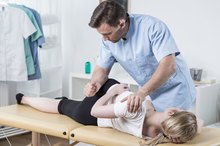What Is Considered Your Upper Abdomen?
When you perform abdominal exercises, you often target your upper or lower abdomen for work. While standard crunches or curls will put stress on the upper abs, reverse crunches or hip lifts will blast the lower abs. You may think you’re working two muscles, but the abdominal muscle, or rectus abdominis, is technically a single long muscle. However, the nervous system functions in such a way that you can target different regions of one muscle.
The Six-Pack
Your abdominal muscle is divided into sections by vertical and horizontal tendinous inscriptions, or collagen connective tissue. The vertical line of white tissue that runs down the middle of your abs is called the linea alba. If you’re in good shape and lean, the sections of your abdominal muscle are visible, and are commonly referred to as the “six-pack” or “washboard abs.” Thousands of crunches will not alter the width and depth of these tendinous inscriptions, which are determined by your genetic inheritance. If you want to see a defined upper abdomen, you may have to lose the fat around your midsection and hope that your DNA serves you well.
Upper Versus Lower Abdomen
Physical Therapy Treatment for a Long Thoracic Nerve
Learn More
Different areas of a muscle can be selectively stimulated by your nervous system, which is called segmental nerve innervation, according to Douglas Brooks’ “Effective Strength Training: Analysis and Technique for Upper-Body, Lower-Body and Trunk Exercises.” When you perform an abdominal exercise that targets the upper abs, the entire abdominal muscle is activated or stimulated by the nerves. However, the upper abdominal fibers are stimulated to a greater degree than the lower abdominals.
The Abdominal Cavity
The abdominal cavity consists of the front abdominal wall, abdominal muscles, pelvic bones and the spinal column. It is typically divided into four quadrants: upper right, upper left, lower right and lower left. The upper right quadrant contains various organs, including the gallbladder, liver, right kidney, the head of the pancreas and part of the small intestine and colon. In the upper left quadrant are the spleen, stomach, left kidney, the tail of the pancreas and another part of the small intestine and colon. Similar to chest trauma, blunt trauma to the abdomen in sports, for example, can lead to serious injuries, intensive care and surgery. For instance, when a player bashes into another player, equipment or a barrier, he can injure his spleen.
Upper Abdominal Pain
Causes of Upper Right Back Pain
Learn More
According to the Mayo Clinic, there are several causes of upper abdominal pain, which include angina, or decreased blood flow to your heart, appendicitis, gallstones, heart attack, pancreatitis, peptic ulcer, pleurisy and pneumonia. If you feel pressure in your chest or have suffered from a trauma from an accident, seek emergency medical attention or ring 911. Also seek medical attention if you’re experiencing nausea, vomiting, bloody stools or a swollen abdomen. Steer clear of over-the-counter pain relievers, which can irritate your stomach and magnify the pain.
Related Articles
References
- Effective Strength Training: Analysis and Technique for Upper-Body, Lower-Body and Trunk Exercises; Douglas Brooks
- Pediatric Sports Medicine for Primary Care; Richard B. Birrer, et al.
- 68W Advanced Field Craft: Combat Medic Skills; Casey Bond, et al.
- Mayo Clinic: Abdominal Pain
- Mayo Clinic: When to See a Doctor
Resources
Writer Bio
Kay Tang is a journalist who has been writing since 1990. She previously covered developments in theater for the "Dramatists Guild Quarterly." Tang graduated with a Bachelor of Arts in economics and political science from Yale University and completed a Master of Professional Studies in interactive telecommunications at New York University.






